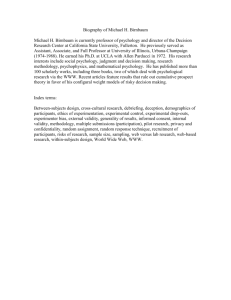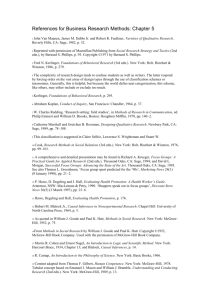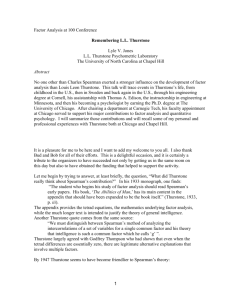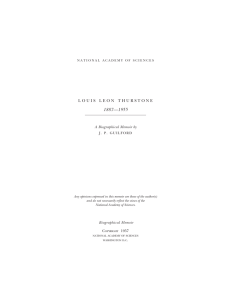References for Business Research Methods: Chapter 12
advertisement
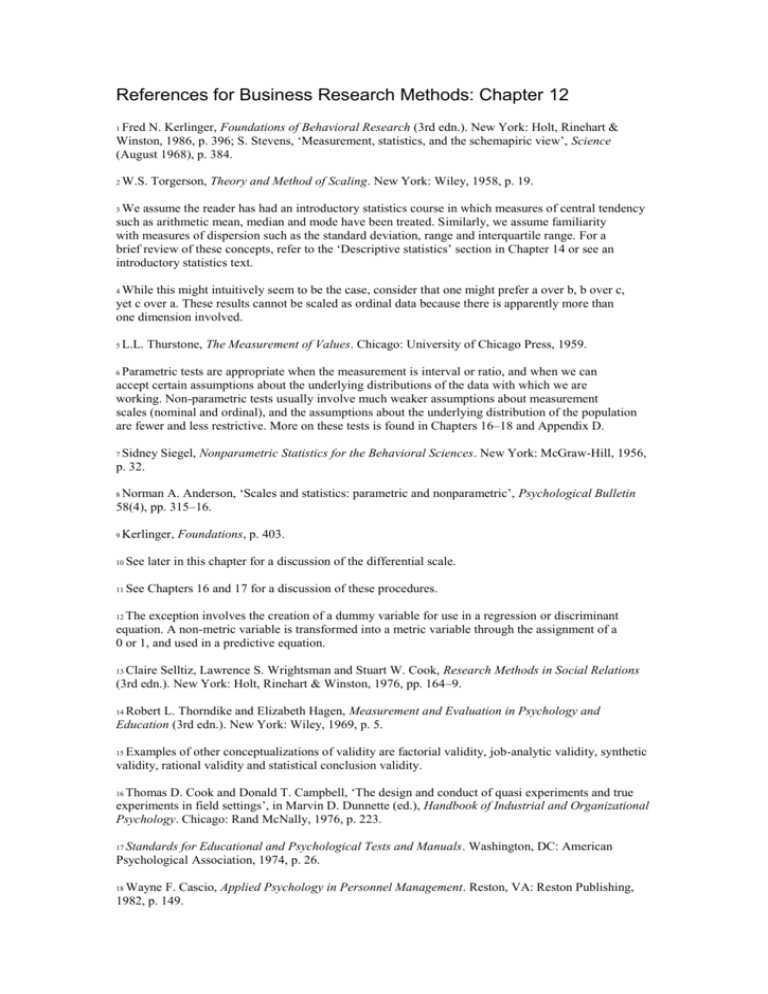
References for Business Research Methods: Chapter 12 Fred N. Kerlinger, Foundations of Behavioral Research (3rd edn.). New York: Holt, Rinehart & Winston, 1986, p. 396; S. Stevens, ‘Measurement, statistics, and the schemapiric view’, Science (August 1968), p. 384. 1 2 W.S. Torgerson, Theory and Method of Scaling. New York: Wiley, 1958, p. 19. We assume the reader has had an introductory statistics course in which measures of central tendency such as arithmetic mean, median and mode have been treated. Similarly, we assume familiarity with measures of dispersion such as the standard deviation, range and interquartile range. For a brief review of these concepts, refer to the ‘Descriptive statistics’ section in Chapter 14 or see an introductory statistics text. 3 While this might intuitively seem to be the case, consider that one might prefer a over b, b over c, yet c over a. These results cannot be scaled as ordinal data because there is apparently more than one dimension involved. 4 5 L.L. Thurstone, The Measurement of Values. Chicago: University of Chicago Press, 1959. Parametric tests are appropriate when the measurement is interval or ratio, and when we can accept certain assumptions about the underlying distributions of the data with which we are working. Non-parametric tests usually involve much weaker assumptions about measurement scales (nominal and ordinal), and the assumptions about the underlying distribution of the population are fewer and less restrictive. More on these tests is found in Chapters 16–18 and Appendix D. 6 Sidney Siegel, Nonparametric Statistics for the Behavioral Sciences. New York: McGraw-Hill, 1956, p. 32. 7 Norman A. Anderson, ‘Scales and statistics: parametric and nonparametric’, Psychological Bulletin 58(4), pp. 315–16. 8 9 Kerlinger, Foundations, p. 403. 10 See later in this chapter for a discussion of the differential scale. 11 See Chapters 16 and 17 for a discussion of these procedures. The exception involves the creation of a dummy variable for use in a regression or discriminant equation. A non-metric variable is transformed into a metric variable through the assignment of a 0 or 1, and used in a predictive equation. 12 Claire Selltiz, Lawrence S. Wrightsman and Stuart W. Cook, Research Methods in Social Relations (3rd edn.). New York: Holt, Rinehart & Winston, 1976, pp. 164–9. 13 Robert L. Thorndike and Elizabeth Hagen, Measurement and Evaluation in Psychology and Education (3rd edn.). New York: Wiley, 1969, p. 5. 14 Examples of other conceptualizations of validity are factorial validity, job-analytic validity, synthetic validity, rational validity and statistical conclusion validity. 15 Thomas D. Cook and Donald T. Campbell, ‘The design and conduct of quasi experiments and true experiments in field settings’, in Marvin D. Dunnette (ed.), Handbook of Industrial and Organizational Psychology. Chicago: Rand McNally, 1976, p. 223. 16 Standards for Educational and Psychological Tests and Manuals. Washington, DC: American Psychological Association, 1974, p. 26. 17 Wayne F. Cascio, Applied Psychology in Personnel Management. Reston, VA: Reston Publishing, 1982, p. 149. 18 19 Thorndike and Hagen, Measurement and Evaluation, p. 168. See, for example, Cascio, Applied Psychology, pp. 146–7; Edward G. Carmines and Richard A. Zeller, Reliability and Validity Assessment. Beverly Hills, CA: Sage, 1979, pp. 48–50. 20 Emanuel J. Mason and William J. Bramble, Understanding and Conducting Research. New York: McGraw-Hill, 1989, pp. 260–3. 21 22 Cascio, Applied Psychology, pp. 135–6. 23 Mason and Bramble, Understanding and Conducting Research, p. 268. 24 Thorndike and Hagen, Measurement and Evaluation, p. 199. Martin Patchen, Some Questionnaire Measures of Employee Motivation and Morale, Monograph No. 41. Ann Arbor: Institute for Social Research, University of Michigan, 1965, p. 17. 25 26 Ibid., p. 25. Bernard S. Phillips, Social Research Strategy and Tactics (2nd edn.). New York: Macmillan, 1971, p. 205. 27 For a discussion of various scale classifications, see W.S. Torgerson, Theory and Methods of Scaling. New York: Wiley, 1958, Chapter 3. 28 E.A. Suchman and R.G. Francis, ‘Scaling techniques in social research’, in J.T. Doby (ed.), An Introduction to Social Research. Harrisburg, PA: Stackpole, 1954, pp. 126–9. 29 A study of the historic research literature found that more than three-quarters of the attitude scales used were of the five-point type. An examination of more recent literature suggests that the fivepoint scale is still common but that there is a growing use of longer scales. For the historic study, see Daniel D. Day, ‘Methods in attitude research’, American Sociological Review 5 (1940), pp. 395–410. Single versus multiple-item scaling requirements are discussed in Jum C. Nunnally, Psychometric Theory. New York: McGraw-Hill, 1967, Chapter 14. 30 This section is adapted from Pamela L. Alreck and Robert B. Settle, The Survey Research Handbook. Burr Ridge, IL: Irwin, 1995, Chapter 5. 31 32 J.P. Guilford, Psychometric Methods. New York: McGraw-Hill, 1954, pp. 278–79. 33 P.M. Synonds, ‘Notes on rating’, Journal of Applied Psychology 9 (1925), pp. 188–95. 34 See L.L. Thurstone, ‘A law of comparative judgment’, Psychological Review 34 (1927), pp. 273–86. 35 Guilford, Psychometric Methods. See Milton A. Saffir, ‘A comparative study of scales constructed by three psychophysical methods’, Psychometrica 11(3) (September 1937), pp. 179–98. 36 Allen L. Edwards, Techniques of Attitude Scale Construction. New York: Appleton-Century-Crofts, 1957, pp. 152–4. 37 One study reported that the construction of a Likert scale took only half the time required to construct a Thurstone scale. See L.L. Thurstone and K.K. Kenney, ‘A comparison of the Thurstone and Likert techniques of attitude scale construction’, Journal of Applied Psychology 30 (1946), pp. 72–83. 39 Edwards, Techniques, p. 153. 38 Louis Guttman, ‘A basis for scaling qualitative data’, American Sociological Review 9 (1944), pp. 139–50. 40 John P. Robinson, ‘Toward a more appropriate use of Guttman scaling’, Public Opinion Quarterly 37 (Summer 1973), pp. 260–7. 41 42 For more on the process of factor analysis, see Chapter 18. Charles E. Osgood, G.J. Suci and P.H. Tannenbaum, The Measurement of Meaning. Urbana, IL: University of Illinois Press, 1957. 43 Ibid., p. 49. See also James G. Snider and Charles E. Osgood (eds.), Semantic Differential Technique. Chicago: Aldine, 1969. 44 45 Ibid., p. 79. See, for example, Joseph B. Kruskal and Myron Wish, Multidimensional Scaling. Beverly Hills, CA: Sage, 1978; Paul Green and V.R. Rao, Applied Multidimensional Scaling: A Comparison of Approaches and Algorithms. New York: Holt, Rinehart & Winston, 1972; Paul E. Green and F.J. Carmone, Multidimensional Scaling in Marketing Analysis. Boston: Allyn & Bacon, 1970. 46 See P. Cattin and D.R. Wittink, ‘Commercial use of conjoint analysis: a survey’, Journal of Marketing 46 (1982), pp. 44–53; Cattin and Wittink, ‘Commercial use of conjoint analysis: an update’, paper presented at the ORSA/TIMS Marketing Science Meetings, Richardson, TX, 12–15 March 1986. 47 Jordan J. Louviere, Analyzing Decision Making: Metric Conjoint Analysis. Beverly Hills, CA: Sage, 1988, pp. 9–11. 48 See, for example, Milton Lodge, Magnitude Scaling: Quantitative Measurement of Opinions. Beverly Hills, CA: Sage, 1981; Donald R. Cooper and Donald A. Clare, ‘A magnitude estimation scale for human values’, Psychological Reports 49 (1981). 49 50 David Andrich, Rasch Models for Measurement. Beverly Hills, CA: Sage, 1988.
